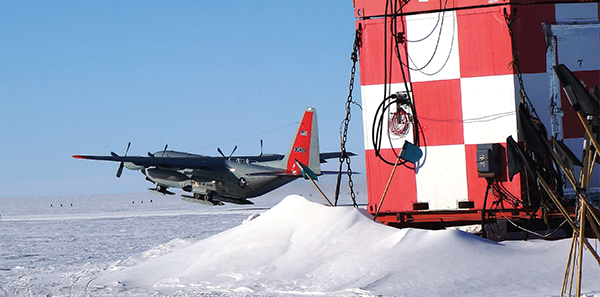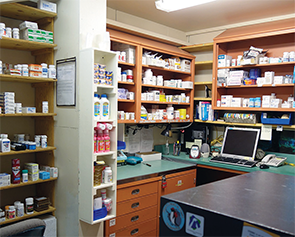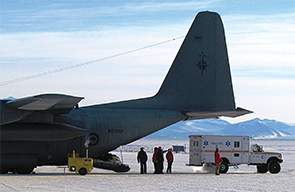
If diversity is the spice of life—and EM practice—then medical practice here at McMurdo Station is pretty zesty. The last flights for the summer staff have left, dropping our population from a high of about 1,200 to, at most, 200 (plus 11 to 17 Kiwis at nearby Scott Base). The medical staff has also pared down from summer’s eight clinicians to only myself and a physician assistant. While there may be some dull moments, there are enough high points to enliven things or at least to provide a memorable experience.
Explore This Issue
ACEP Now: Vol 35 – No 05 – May 2016Settling In
Our hospital, a Navy-built facility dating back roughly 50 years, is filled with nooks and crannies, cupboards, and cabinets stocked with all sorts of modern and antiquated medical equipment. I must be able to quickly locate what we need in any situation. I also began to learn the intricacies of our crash carts (we have two), monitor-defibrillators (several), ventilators (several), lab equipment and POC tests, and ultrasound machines (two—one brand-new).
However, my initial task was to get a grasp of the complex paperwork that accompanies any patient interaction: completing the online log, typing the chart and sending it to two different locations, and completing work-injury reports when necessary. More paperwork and computer manipulations accompany radiologic procedures (we’re also rad techs), dental procedures (I’m now the dentist), lab procedures (we’re the medical technologists), and filling prescriptions (we’re the pharmacists, with a large formulary). Finally, if we need to send someone off The Ice for medical reasons, there’s another set of paperwork and a long protocol of many phone calls. All that brings me to my first patient.
First Emergency
Arriving early at the clinic on my third day on The Ice, I was met by a young man being helped into the facility. Slightly bent over, he was obviously having abdominal pain. A quick exam showed that he had all the classic symptoms of appendicitis. We had already begun the recommended heavy-duty antibiotics and provided some analgesia when our flight surgeon, Steve Guyton, who would be going home shortly to his civilian EM position, arrived. While I called our medical chief in Galveston, Texas, Steve called the flight line and arranged for the LC-130, which was scheduled to leave The Ice in one hour, to wait for our patient’s arrival. In what may be record time, 90 minutes after arriving at our small hospital, the patient was on his way to Christchurch, New Zealand, where he had a successful appendectomy.
The “McMurdo Crud”

The pharmacy at McMurdo Station.
While Antarctica offers expansive landscapes and intense drama, for one week, my mind was focused only on breathing through my nose and trying not to cough all night. This counts as a memorable, but not lively, experience. I had, as we say down here, the “McMurdo Crud.” Given that our small population lives, eats, and works together, nearly everyone has the joy of experiencing the Crud, hopefully only once per season. Thankfully, we don’t have massive influenza outbreaks since everyone is required to have a flu shot before deploying to the station. We will have some personnel rotations this winter, potentially exposing us to new flu strains, so we’ll be updating everyone’s flu shot in June with New Zealand’s annual formulation, which is the same as that used in the United States.
Lab Work
In the days before federal Clinical Laboratory Improvement Amendments (CLIA) regulations, I routinely did simple tests in our ED physician laboratory. During my Arctic sojourn for a research fleet, I employed additional simple lab tests. Here at McMurdo, however, we have CLIA-approved machines to run complete blood counts (CBCs), multiple blood chemistries, troponins, etc. The challenge is to keep unexpired tests and quality-control materials on hand since we’re at the end of a very long supply chain. Of course, I still do the urines the old-fashioned way, with a dipstick and microscope. Luckily, our newest CBC machine does its own centrifuging since people forget that failing to secure capillary tubes before spinning them destroys the machine.
Driving

An ambulance delivers a patient to a medevac plane.
Everyone here has more than one job, with your secondary position designed to assist the whole base. I volunteered to drive one of our 12-person vans to shuttle people around. This required learning the special driving rules for the station (go very, very slowly and cede the road to everyone else), learning how to check maintenance, learning the complex method of gassing the vehicle (multiple codes and key insertions), as well as proving that I could drive on ice and snow; it’s no different than driving on ice and snow anywhere else. After I became an official driver, I was allowed to shuttle McMurdo residents to one of the popular “American Nights” at New Zealand’s nearby Scott Base, where both their bar and store, with very nice souvenirs, are open for business.
My next stint as a driver was totally unexpected: I was needed to drive an ambulatory medevac patient to the airfield. The outgoing summer physician and our US Air Force flight medic were his attendants. We got into the van and began our trip to the “skier” airfield, where the LC-130s use skis to land and take off. Because our patient was a New Zealander and we were passing by Scott Base, we followed tradition and stopped at the base so that his many compatriots, including a bagpiper, could wish him farewell. The whole experience was awesome. It’s not every day that I have the chance to drive onto an active airfield and up to an airplane getting ready for takeoff.
We assumed that once he got back to civilization, his dentist could determine if a root canal was possible or if he would need an extraction. When told of these options, the patient unexpectedly chose immediate extraction. He’d had enough problems with that tooth, and he just wanted it gone.
Life as a Dentist
I was deep in administrative duties when my first real dental patient walked in. The middle-aged man explained that he’d long had problems with a molar (#14, for those into dentistry). His dentist had previously considered extracting it but thought that it would be too difficult, so she elected to clean out the large carie and fill it. For two days, the tooth had been causing him excruciating pain that prevented him from sleeping. After taking a dental history (heat caused pain, he didn’t feel cold, and the pain came without any provocation) and performing a dental exam with a mirror, probe, “tooth sleuth,” and Endo Ice, I took dental films. Luckily, our dental film system is now digital. I don’t have to go through the laborious process of trying to develop films inside a small box as our prior dentists had to do.
Following our dental protocol, I then sent the films and a short description to our consulting dentist, who had taught me some dentistry before he finished his annual six-week stint at the station. I then called him to discuss various options to buy time until the patient left the station three weeks later: analgesics and antibiotics coupled with mechanically adjusting the bite by using “articulation paper” to mark the high spots and then grinding them down. We assumed that once he got back to civilization, his dentist could determine if a root canal was possible or if he would need an extraction. When told of these options, the patient unexpectedly chose immediate extraction. He’d had enough problems with that tooth, and he just wanted it gone.
While I’ve extracted teeth in resource-poor settings, this was the first time that I would do it using professional instruments and with the expectation that the level of care would be the same quality as from a real dentist. No worries, as our Kiwi neighbors say. I turned on the power, air, and vacuum for our dental instruments, then positioned the dental chair and rooted through the mass of tools to find the special high-pressure lidocaine syringe for effective apical tooth infiltration, periosteal elevators, and the correct dental forceps. (I chose the latter almost correctly, using a 53R designed for the right side rather than the 53L that is normally used on the left.) With my physician assistant as my dental assistant, I cut the periodontal ligaments and gently rocked the tooth, similar to removing a post from a muddy hole. After about eight minutes, it came out—intact. Everyone, especially the patient, was very pleased with the result.
Playing the odds, I assume that my next dental case will be either replacing a crown (cap) or placing a filling. I can’t wait! But that’s medicine on The Ice.
Dr. Iserson is professor emeritus of emergency medicine at The University of Arizona in Tucson.
Pages: 1 2 3 | Multi-Page




One Response to “Fun, Friends, Flexible Hours Part of Providing Medical Care in Antarctica”
November 27, 2019
Lori PartonMy name is Lori Parton. I am ardms registered in ultrasound in abdomen, OB, high risk OB, cardiac, vascular, and I am a registered Radiology technologist. I have 25 + years experience and have my own ultrasound machine … Seimens Antares XP. How do I serve a term in Antarctica?